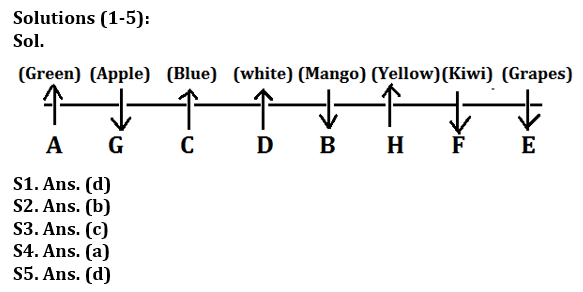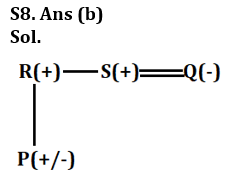Direction (1-5): Study the following information carefully and answer the questions given below-
Eight persons are sitting in a row, some are facing north, and some are facing south. Those who are facing in north likes colour and those who are facing in south likes fruits. More than four persons sit between A and the one who likes kiwi. D sits third to the right of A. Only two persons sit between H and C who likes blue colour. G sits second to the left of the one who sits fourth to the right of E. E is not an immediate neighbor of A. The one who likes mango sits third to the left of G. H is neither an immediate neighbour of A nor of D. A likes green colour. The one who likes yellow colour sits second to the right of the one who likes grapes. E does not like kiwi. The one who likes white colour sits third to the right of F. B sits third to the left of the one who likes apple.
Q1. Who among the following sits third to the right of the one who likes White?
(a) H
(b) A
(c) the one who likes grapes
(d) The one who likes Kiwi
(e) B
Q2. How many persons sit between G and the one who likes yellow colour?
(a) None
(b) Three
(c) One
(d) More than Three
(e) Two
Q3. Which of the following statement true about F?
(a) F likes grapes
(b) D sits second to the right of F
(c) Three persons sit between F and C
(d) F likes white colour
(e) All are true
Q4. What is the position of C with respect to H?
(a) Third to the left
(b) Second to the right
(c) Immediate Right
(d) Second to the left
(e) Immediate left
Q5. Who among the following likes Apple?
(a) E
(b) H
(c) D
(d) G
(e) A
Directions (6-10): Each of the questions below consists of a question and two statements numbered I and II given below it. You have to decide whether the data provided in the statement are sufficient to answer the question. Read both the statements and Give answer:
(a) If the data in statement I alone are sufficient to answer the question, while the data in statement II alone are not sufficient to answer the question.
(b) If the data in statement II alone are sufficient to answer the question, while the data in statement I alone are not sufficient to answer the question.
(c) If the data either in statement I alone or in statement II alone are sufficient to answer the question.
(d) If the data even in both statements I and II together are not sufficient to answer the question.
(e) If the data in both statements I and II together are necessary to answer the question.
Q6. Who among J, K, L and M reached office first?
I. J reached office after L and before M but did not second last to reach office
II. K reached office after M
Q7. Among A, B, C, D and E each one of them has different height, who among the following is the second shortest?
I. D is taller than A and B
II. E is shorter than C and taller than D
Q8. There are five persons in a family namely P, Q, R, S and T. How is S related to P?
I. T is cousin of P and son of Q, who married to S
II. R is father of P and brother of S. Q is wife of S
Q9. Among A, B, C, D, E and F are sitting in a circle facing center, who among the following person sit immediate right of D?
I. A faces B. Only one person sits between B and D.
II. D sits second to the right of A, Who Sits immediate left of C.
Q10. Seven boxes are placed one above other which of the following box is placed immediately above the Box H?
I. Three Box are placed between Box B and F, which is placed immediately above box L.
II. Three box are placed between Box L and Box H. Box L is placed below box H.
Directions (11-15): A word/number arrangement machine when given an input line of word/numbers rearranges them following a particular rule. The following is an illustration of input and rearrangements.
Input: caliber 49 cannibal 52 caution 43 caustic 39 camphor 62
Step I: 60 caliber 49 cannibal 52 caution 43 caustic 39 camphor
Step II: 60 caustic caliber 49 cannibal 52 caution 43 39 camphor
Step III: 60 caustic 50 caliber 49 cannibal caution 43 39 camphor
Step IV: 60 caustic 50 caution caliber 49 cannibal 43 39 camphor
Step V: 60 caustic 50 caution 47 caliber cannibal 43 39 camphor
Step VI: 60 caustic 50 caution 47 cannibal caliber 43 39 camphor
Step VII: 60 caustic 50 caution 47 cannibal 41 caliber 39 camphor
Step VIII: 60 caustic 50 caution 47 cannibal 41 camphor caliber 39
Step IX: 60 caution 50 caustic 47 cannibal 41 camphor 37 caliber
Step IX is the last step of the rearrangements, Based on the following logic rearrange the given input.
Input: mammals 65 laying 59 eggs 71 are 93 seldom 33
Q11. How many steps are required to complete the arrangements?
(a) Seven
(b) Six
(c) Eight
(d) Nine
(e) None of these
Q12. What will be the Step III of the given input?
(a) 91 seldom 69 mammals 63 laying 59 eggs are 33
(b) 91 seldom 69 mammals 65 laying 57 eggs are 33
(c) 91 seldom 69 mammals 65 laying 59 eggs are 33
(d) 91 seldom 71 mammals 65 laying 59 eggs are 33
(e) None of these
Q13. What is the position of ‘63’ from right end in Step VII?
(a) Second
(b) Third
(c) Fourth
(d) Fifth
(e)There is no such step
Q14. ‘91 seldom 69 mammals 63 laying 57 eggs are 33’ represents which step of the given input?
(a) Step IV
(b) Step V
(c) Step VI
(d) Step VII
(e) None of these
Q15. What is the sum of the term which is 5th from the left end in step I and the term which is second last from the right end in step VI?
(a) 94
(b) 92
(c) 90
(d) 88
(e) None of these
Solutions

Solutions (6-10):
S6. Ans (a)
Sol. L>J>M>K
S7. Ans (d)
Sol. C>E>D>A/B>A/B

S9. Ans(d)
S10. Ans(e)
Sol. From statement I and II we can find box B is placed immediately above Box H.
Solutions (11-15):
Sol. Decoding the logic: The logic followed here is: In first step the highest number is arranged from the left side after subtracting 2 with it. And in the second step the word is arranged in the reverse alphabetical order after the number arranged in the first step. This process is repeated till the last step.
Input: mammals 65 laying 59 eggs 71 are 93 seldom 33
Step I: 91 mammals 65 laying 59 eggs 71 are seldom 33
Step II: 91 seldom mammals 65 laying 59 eggs 71 are 33
Step III: 91 seldom 69 mammals 65 laying 59 eggs are 33
Step IV: 91 seldom 69 mammals 63 laying 59 eggs are 33
Step V: 91 seldom 69 mammals 63 laying 57 eggs are 33
Step VI: 91 seldom 69 mammals 63 laying 57 eggs 31 are
S11. Ans. (b)
S12. Ans. (c)
S13. Ans. (e)
S14. Ans. (b)
S15. Ans. (c)





 GA Capsule for SBI Clerk Mains 2025, Dow...
GA Capsule for SBI Clerk Mains 2025, Dow...
 The Hindu Review October 2022: Download ...
The Hindu Review October 2022: Download ...
 ECGC PO Scorecard 2025 Out, Check Marks
ECGC PO Scorecard 2025 Out, Check Marks




